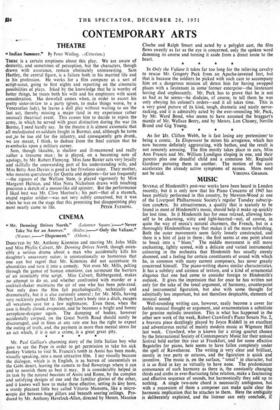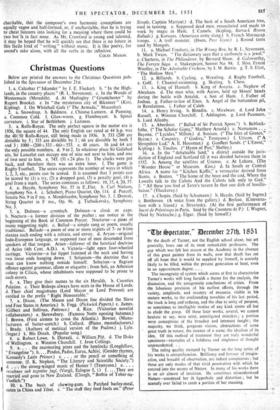MUSIC
SEVERAL of Hindemith's post-war works have been heard in London recently, but it is only now that his Piano Concerto of 1945 has been publicly performed in this country, by Mewton-Wood at one of the Liverpool Philharmonic Society's regular Tuesday subscrip- tion conctrts. Its attractiveness, a quality that is scarcely to be found in most of Hindemith's music, should help it make up quickly for lost time. In it Hindemith has for once relaxed, allowing him- self to be charming, witty and light-hearted—not, of course, in quite the way of music's natural charmers, the French, but in a thoroughly Hindemithian way that makes it all the more refreshing. Both the outer movements seem fairly loosely constructed, and there is a hint of jazz in them ; the first seems at one point about to break into a "blues." The middle movement is still more enchanting, lightly scored,,with a delicate and varied instrumental colouring in the orchestra that Hindemith has usually sternly shunned, and a feeling for certain constituents of sound with which he, in common with many earnest composers, has never greatly concerned himself. The piano-writing shows similar characteristics. It has a subtlety and airiness of texture, and a kind of ornamental elegance that one had come to consider foreign to Hindemith's Outlook. It gives the impression that for once he has written not only for the sake of the tonal argument, of harmony, counterpoint and instrumental figuration, but also with some thought for admittedly less important, but not therefore despicable, elements of musical sound.
Well-sounding writing can, however, easily become a cover for feeble musical thought or argument, and ornamentation a substitute for genuine melodic invention. This is what has happened in the other new work of the week, Robert Crawford's Piano Sonata No. 2, a bravura piece dazzlingly played by Joyce Riddell in an excellent and adventurous recital of mainly modern music at Wigmore Hall last week. Crawford, who is known for a string quartet chosen by the International Society of Contemporary Music for their annual festival held earlier this year at Frankfurt, and for some effective Bagatelles for piano, here seems to have fallen completely under the spell of Rawsthorne. The writing is very clear and brilliant, mostly in two parts or octaves, and the figuration is quick and inventive. The music is, on the surface, " tonal " in character, but it is so fluid in key as virtually to have none. The predominant consonance of such harmony as there is, the constantly changing
thirds and sixths in ever-fluctuating false relation, make a fascinating and effective sequence of sounds, but harmonically they add up to nothing. A single two-note chord is necessarily ambiguous, but with a succession of them a composer can make quite clear the harmonic implication that he attaches to them. Here the ambiguity is deliberately exploited, and the listener can only conclude, if charitable, that the composer's own harmonic conceptions are equally vague and half-formed, or, if uncharitable, that he is trying to cheat listeners into looking for a meaning where there could be two but Ts in fact none. As Mr. Crawford is young and talented, it may be hoped that he will quickly see that there is no future in this facile kind of " writing " without music. It is like poetry, for sound's sake alone, with all the verbs in the infinitive.
COLIN MASON.































 Previous page
Previous page